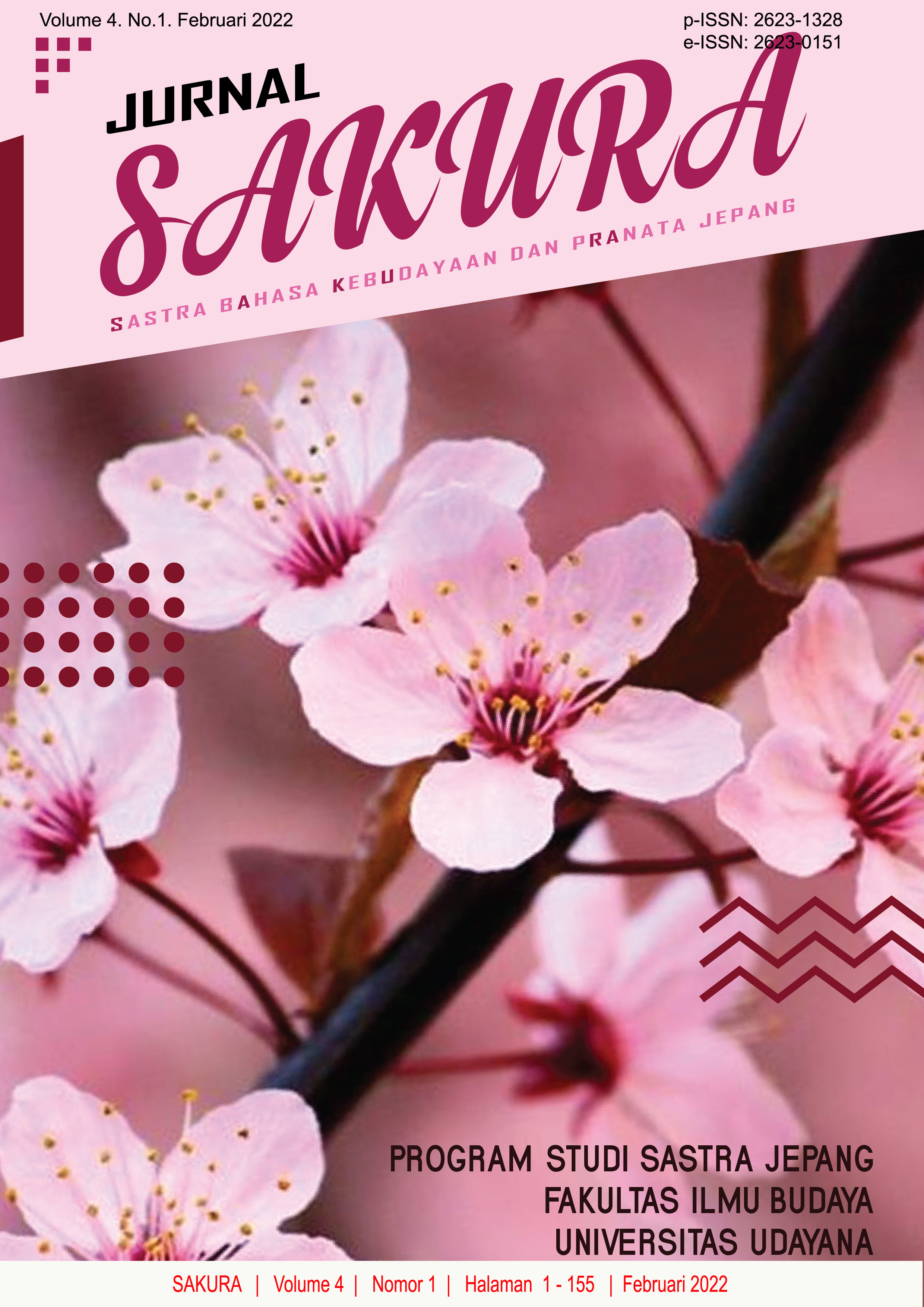Ideologi Di Balik Mitos Dalam Cerpen Akagaeru Karya Shimaki Kensaku: Kajian Semiologi Roland Barthes
Abstract
This article examines the ideology of Shimaki Kensaku in the short story Akagaeru. This study is qualitative research by applying the hermeneutic method. This study uses the semiology theory of Roland Barthes with a two-level sign interpretation model. The results of the study show that at the language level, the signifier of akagaeru refers to the signified of reddish-brown type of frog endemic to Japan. The signified at the language level become the signifier of connotation at the myth level which refers to the signified of connotation namely 1) return to the original Japanese ideology; 2) the failure of communist ideology to develop in Japan; 3) acceptance of the destruction of communist ideology in Japan; and 4) persistence of admiration for communist ideology. These signified of connotations form a myth that is connected with Shimaki Kensaku's ideology, namely suichoku tenk? 'vertical tenk?'
Downloads
References
Barthes, R. (1972) Mythologies. New York: Noonday Press.
Barthes, R. (1977) Image Music Text. London: Fontana Press.
Bix, H. P. (1982) ‘Rethinking “Emperor-System Fascism”: Ruptures and Continuities in Modern Japanese History’, Critical Asian Studies, 14(2), pp. 2–19. doi: 10.1080/14672715.1982.10412644.
Brownlee, J. S. (2000) ‘Four Stages of the Japanese Kokutai [National Essence]’, JSAC Conference, October. Available at: http://www.adilegian.com/PDF/brownlee.pdf.
Fukuda, K. and Yano, K. (1969) Shimaki Kensaku: Hito to sakuhin (Shimaki Kensaku: The Man and His Works). Tokyo: Shimizu shoin.
Gomel, E. (1995) ‘The poetics of censorship : allegory as form and ideology in the novels of Arkady and Boris Strugatsky’, Science Fiction Studies1, 22(65), pp. 87–105.
Hamilton, C. (2011) ‘Allegory, blending, and censorship in modern literature’, Journal of Literary Semantics, 40(1), pp. 23–42. doi: 10.1515/jlse.2011.002.
Honda, S. (1985) Tenkō bungaku-ron (A Study of tenkō Literature). Tokyo: Miraisha.
Hoston, G. A. (1983) ‘Tenko : Marxism & the National Question in Prewar Japan’, Polity, 16(1), pp. 96–118. doi: 10.2307/3234524.
Lippit, N. M. (1992) ‘The Dispute Over Socialist Realism In Japan’, Journal of South Asian Literature, 27(2), pp. 67–83.
Long, J. E. (2021) ‘Crossing The Void Shimaki Kensaku’s search for meaning in “Leprosy” and “Blindness”’, in Hayter, I., Sipos, G. T., and Williams, M. (eds) Tenkō Cultures of Political Conversion in Transwar Japan. New York & London: Routledge, pp. 171–184.
Miller, J. S. (2010) The A to Z of Modern Japanese Literature and Theater. Lanhom,Toronto, & Plymouth: The Scarecrow Press.
Moriarty, M. (2006) ‘Ideology and literature’, Journal of Political Ideologies, 11(1), pp. 43–60. doi: 10.1080/13569310500395875.
Naturalism (2003) Nihon Akagaeru. Available at: http://naturalism-2003.com/kansatsu/animal/amphibian/nihonakagaeru.html (Accessed: 8 September 2020).
Ogasawara, M. (1965) Shimaki Kensaku. Tokyo: Meiji shoin.
Ratna, N. K. (2004) Teori, Metode, dan Teknik Penelitian Sastra: Dari Strukturalisme hingga Postrukturalisme Perspektif Wacana Sastra. Yogyakarta: Pustaka Pelajar.
Reinelt, J. (2007) ‘The limits of censorship’, Theatre Research International, 32(1), pp. 3–15. doi: 10.1017/S0307883306002471.
Shimaki, K. (1970) ‘Akagaeru’, in Gendainihon bungaku taikei 70 takeda rintarō shimaki kensaku oda sakunosuke dan kazuo-shū. Tokyo: Chikumashobō.
Shinpo, Y. (1990) Shimaki Kensaku: Gi ni uekawaku mono. Tokyo: Riburopoto.
Steinhoff, P. G. (1991) Tenkō: Ideology and Societal Integration in Prewar Japan. New York and London: Garland Publishing.
Sulatri, N. L. P. A. (2021) ‘Refleksi Tenkō Shimaki Kensaku dalam Cerpen Kuroneko’, in Adnyani, K. E. K. (ed.) Antologi Kajian Linguistik dan Sastra Jepang. Yogyakarta: Deepublish, pp. 110–120.













